transmission Hyundai H-1 (Grand Starex) 2005 Owner's Manual
[x] Cancel search | Manufacturer: HYUNDAI, Model Year: 2005, Model line: H-1 (Grand Starex), Model: Hyundai H-1 (Grand Starex) 2005Pages: 205, PDF Size: 9.14 MB
Page 5 of 205
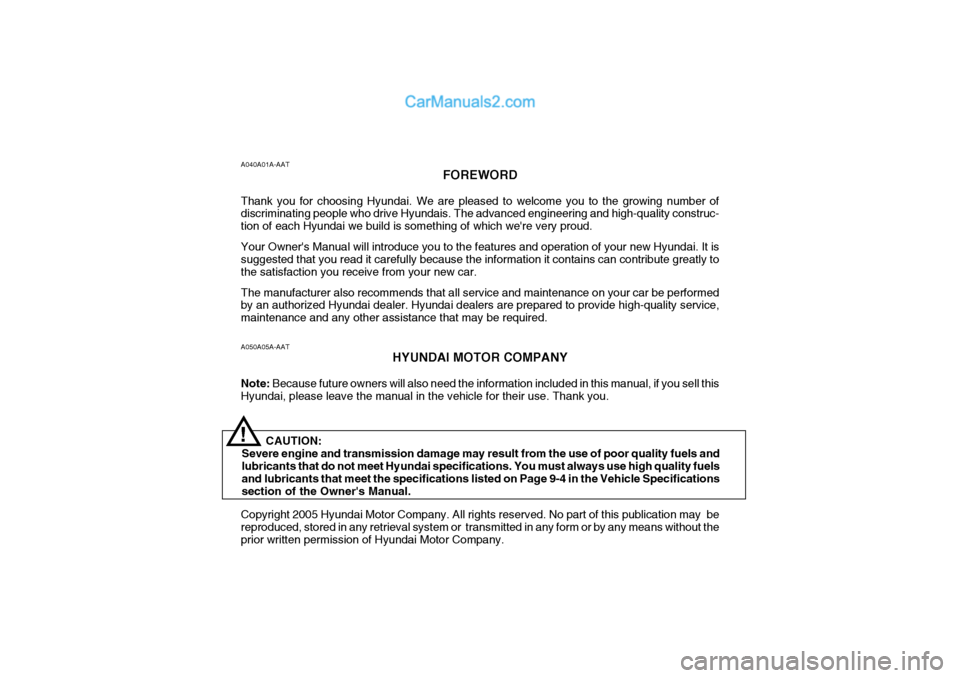
A050A05A-AATHYUNDAI MOTOR COMPANY
Note: Because future owners will also need the information included in this manual, if you sell this
Hyundai, please leave the manual in the vehicle for their use. Thank you. Copyright 2005 Hyundai Motor Company. All rights reserved. No part of this publication may be reproduced, stored in any retrieval system or transmitted in any form or by any means without the prior written permission of Hyundai Motor Company.
A040A01A-AAT
FOREWORD
Thank you for choosing Hyundai. We are pleased to welcome you to the growing number of discriminating people who drive Hyundais. The advanced engineering and high-quality construc- tion of each Hyundai we build is something of which we're very proud. Your Owner's Manual will introduce you to the features and operation of your new Hyundai. It is suggested that you read it carefully because the information it contains can contribute greatly to the satisfaction you receive from your new car. The manufacturer also recommends that all service and maintenance on your car be performed by an authorized Hyundai dealer. Hyundai dealers are prepared to provide high-quality service, maintenance and any other assistance that may be required.
! CAUTION:
Severe engine and transmission damage may result from the use of poor quality fuels and lubricants that do not meet Hyundai specifications. You must always use high quality fuels and lubricants that meet the specifications listed on Page 9-4 in the Vehicle Specifications section of the Owner's Manual.
Page 11 of 205

1. Multi-function light switch
2. Seat warmer switch (If installed)
3. Horn/Driver's side airbag (If installed)
4. Rear heater switch (If installed)
5. Windshield wiper/Washer switch
6. Hazard warning switch
7. Front fog light switch (If installed)
8. 4WD Switch (If installed)
9. Rear fog light switch (If installed)
10. Front/Rear window defroster switch
11. Passenger's side airbag (If installed)
12. Glove box13. Headlight leveling device switch (If installed)
14. ECT switch (Automatic transmission only)
15. Fuel-filler lid release lever
16. Hood release lever
17. Panel brightness control knob (Rheostat) (If installed)
18. Engine RPM adjustment knob (If installed)
19. Heater/Air conditioner control panel
20. Cigarette lighter
21. Ashtray
22. Drink holder
23. Audio system (If installed)
24. Digital clock (If installed)
CAUTION:
When installing the container of liquid air refresher inside a vehicle, do not place it near theinstrument cluster nor on the crash pad surface. If there is any leakage from the air refresher onto these areas (Instrument cluster, crash pad or air ventilator), it may damage these parts. If the liquid from air refresher does leak onto these areas, wash them with water immediately.
!
Page 14 of 205
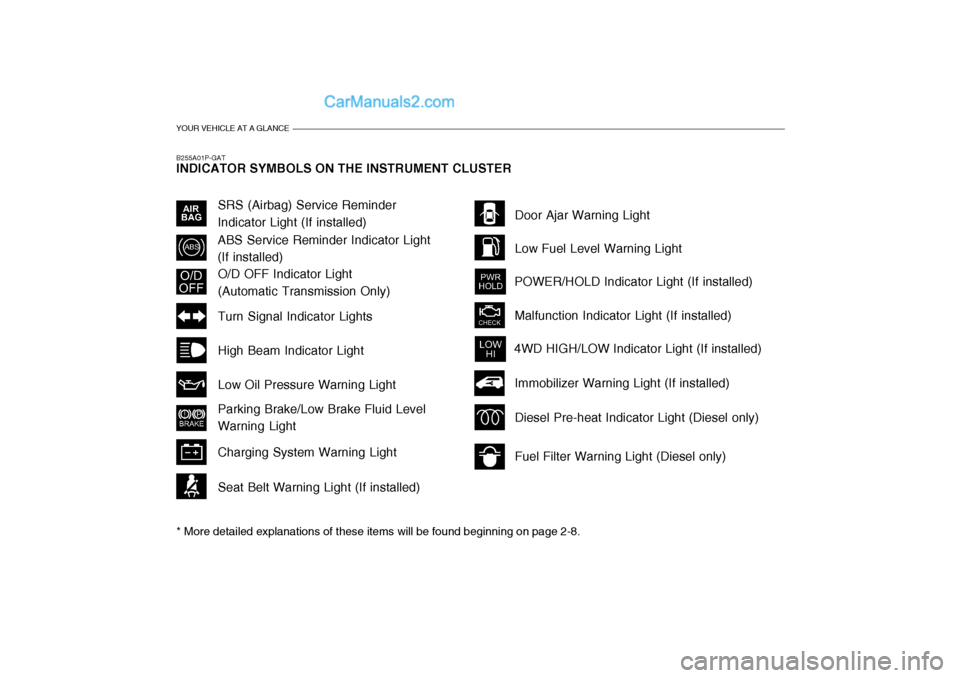
YOUR VEHICLE AT A GLANCE
B255A01P-GAT INDICATOR SYMBOLS ON THE INSTRUMENT CLUSTER * More detailed explanations of these items will be found beginning on page 2-8.
O/D OFF Indicator Light (Automatic Transmission Only)
Fuel Filter Warning Light (Diesel only)
Diesel Pre-heat Indicator Light (Diesel only)
Immobilizer Warning Light (If installed)
SRS (Airbag) Service Reminder Indicator Light (If installed)
ABS Service Reminder Indicator Light(If installed)
Turn Signal Indicator Lights High Beam Indicator LightLow Oil Pressure Warning Light Parking Brake/Low Brake Fluid Level Warning Light Charging System Warning Light Seat Belt Warning Light (If installed) Door Ajar Warning Light Low Fuel Level Warning Light
POWER/HOLD Indicator Light (If installed) Malfunction Indicator Light (If installed)
4WD HIGH/LOW Indicator Light (If installed)
Page 69 of 205

3
Before starting the Engine .......................................... 3-2 Precaution for Exhaust Fumes While
Starting and Driving .................................................... 3-2
To Start the Engine ..................................................... 3-3
Key Positions ............................................................... 3-3Starting........................................................................ 3-4
Manual Transmission .................................................. 3-7
Automatic Transmission .............................................. 3-9Driving with Electronic Dual-Range Automatic
Transmission ............................................................ 3-13
Four-Wheel Drive (4WD) ........................................... 3-15
Brake System ............................................................ 3-19
Anti-Lock Brake System (ABS) ................................. 3-23
Back Warning System ............................................... 3-24
Driving for Economy .................................................. 3-25
Smooth Cornering ..................................................... 3-28
Winter Driving ............................................................ 3-28
Additional Equipment ................................................ 3-31
Locking Differential .................................................... 3-31
STARTING AND OPERATING
3
Page 71 of 205
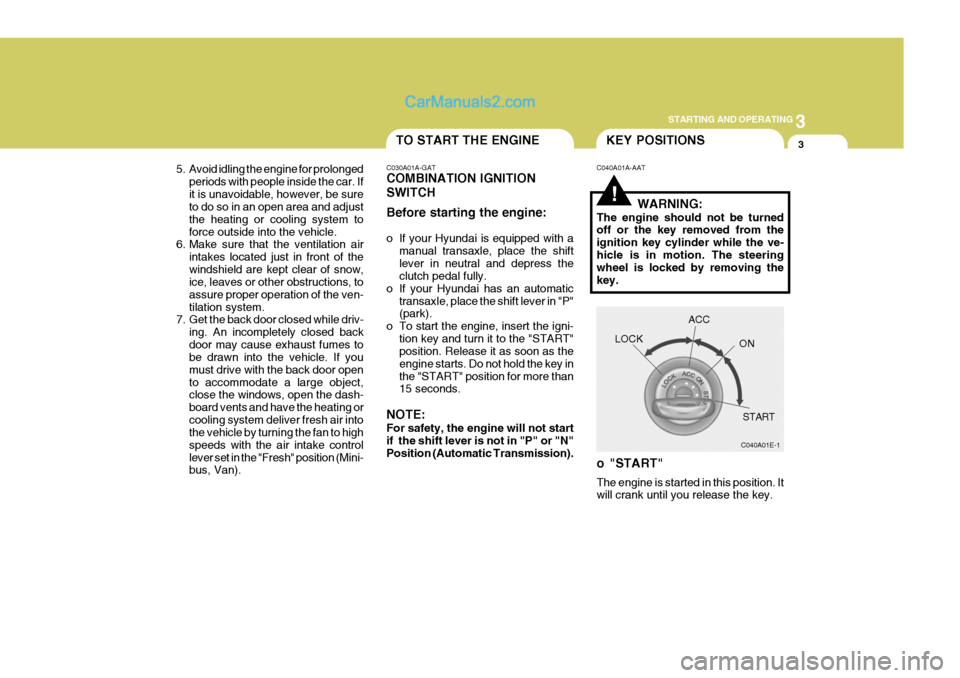
3
STARTING AND OPERATING
3
5. Avoid idling the engine for prolonged
periods with people inside the car. If it is unavoidable, however, be sure to do so in an open area and adjust the heating or cooling system toforce outside into the vehicle.
6. Make sure that the ventilation air
intakes located just in front of thewindshield are kept clear of snow, ice, leaves or other obstructions, to assure proper operation of the ven-tilation system.
7. Get the back door closed while driv-
ing. An incompletely closed backdoor may cause exhaust fumes to be drawn into the vehicle. If you must drive with the back door opento accommodate a large object, close the windows, open the dash- board vents and have the heating orcooling system deliver fresh air into the vehicle by turning the fan to high speeds with the air intake controllever set in the "Fresh" position (Mini- bus, Van).
!
KEY POSITIONS
C040A01A-AAT
C040A01E-1
LOCK
ACC
ON
START
WARNING:
The engine should not be turned off or the key removed from the ignition key cylinder while the ve-hicle is in motion. The steering wheel is locked by removing the key.
o "START" The engine is started in this position. It will crank until you release the key.TO START THE ENGINE
C030A01A-GAT COMBINATION IGNITION SWITCH Before starting the engine:
o If your Hyundai is equipped with a manual transaxle, place the shift lever in neutral and depress the clutch pedal fully.
o If your Hyundai has an automatic transaxle, place the shift lever in "P"(park).
o To start the engine, insert the igni- tion key and turn it to the "START"position. Release it as soon as the engine starts. Do not hold the key inthe "START" position for more than 15 seconds.
NOTE: For safety, the engine will not start if the shift lever is not in "P" or "N" Position (Automatic Transmission).
Page 73 of 205
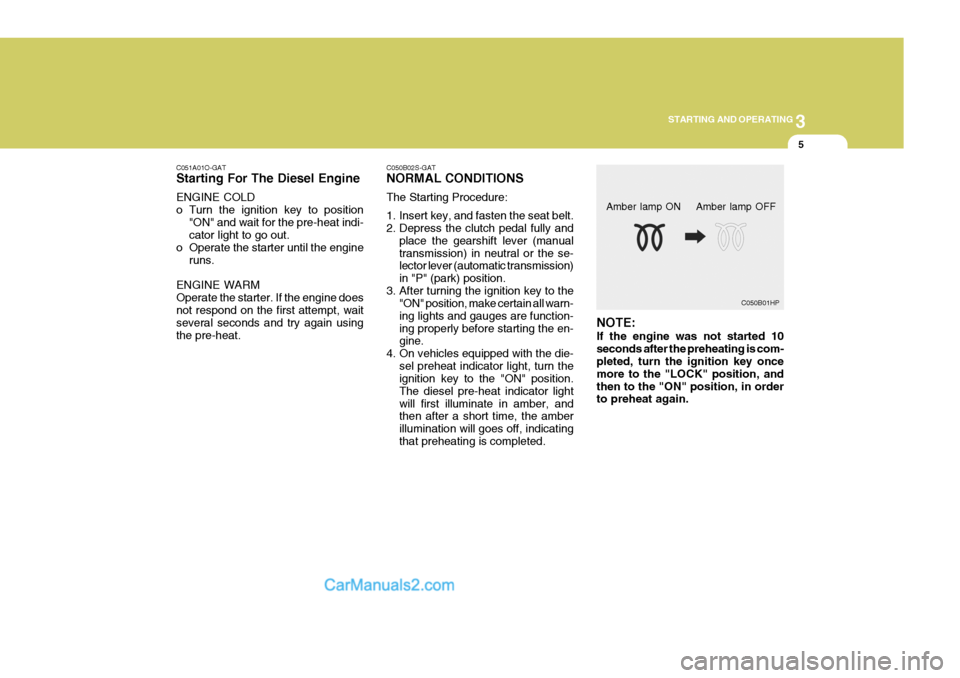
3
STARTING AND OPERATING
5
C051A01O-GAT Starting For The Diesel Engine ENGINE COLD
o Turn the ignition key to position
"ON" and wait for the pre-heat indi- cator light to go out.
o Operate the starter until the engine runs.
ENGINE WARM Operate the starter. If the engine does not respond on the first attempt, wait several seconds and try again usingthe pre-heat. NOTE: If the engine was not started 10 seconds after the preheating is com- pleted, turn the ignition key once more to the "LOCK" position, andthen to the "ON" position, in order to preheat again.C050B01HP
Amber lamp ON Amber lamp OFF
C050B02S-GAT NORMAL CONDITIONS The Starting Procedure:
1. Insert key, and fasten the seat belt.
2. Depress the clutch pedal fully and
place the gearshift lever (manual transmission) in neutral or the se- lector lever (automatic transmission) in "P" (park) position.
3. After turning the ignition key to the "ON" position, make certain all warn-ing lights and gauges are function-ing properly before starting the en- gine.
4. On vehicles equipped with the die- sel preheat indicator light, turn theignition key to the "ON" position. The diesel pre-heat indicator lightwill first illuminate in amber, and then after a short time, the amber illumination will goes off, indicatingthat preheating is completed.
Page 74 of 205
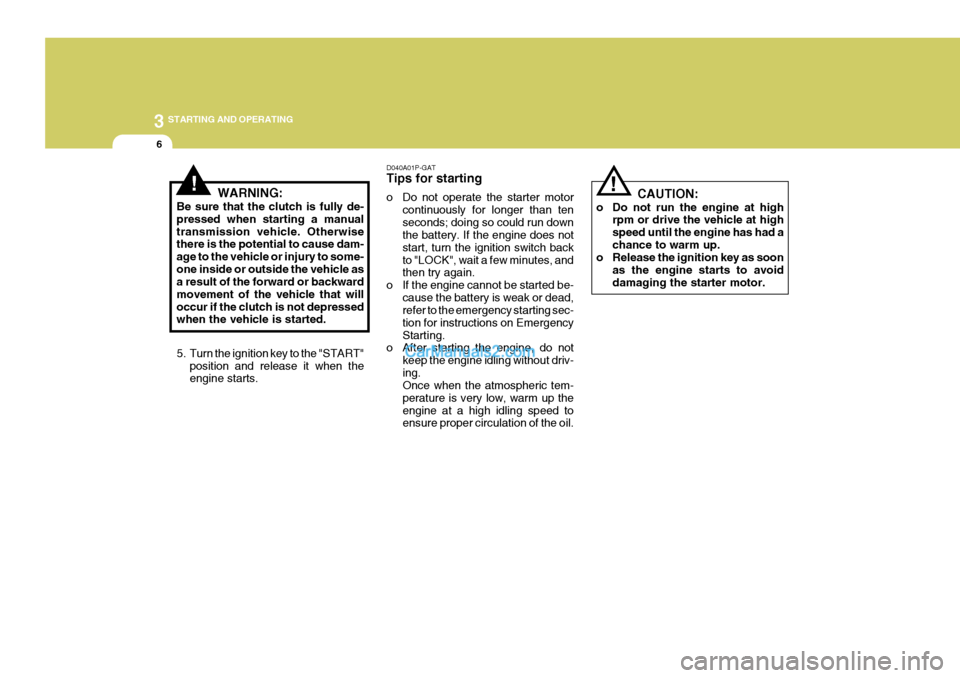
3 STARTING AND OPERATING
6
!WARNING:
Be sure that the clutch is fully de- pressed when starting a manualtransmission vehicle. Otherwise there is the potential to cause dam- age to the vehicle or injury to some-one inside or outside the vehicle as a result of the forward or backward movement of the vehicle that willoccur if the clutch is not depressed when the vehicle is started.
5. Turn the ignition key to the "START" position and release it when theengine starts. D040A01P-GAT Tips for starting
o Do not operate the starter motor
continuously for longer than ten seconds; doing so could run down the battery. If the engine does not start, turn the ignition switch backto "LOCK", wait a few minutes, and then try again.
o If the engine cannot be started be- cause the battery is weak or dead,refer to the emergency starting sec- tion for instructions on EmergencyStarting.
o After starting the engine, do not
keep the engine idling without driv-ing. Once when the atmospheric tem- perature is very low, warm up theengine at a high idling speed to ensure proper circulation of the oil. CAUTION:
o Do not run the engine at high rpm or drive the vehicle at high speed until the engine has had achance to warm up.
o Release the ignition key as soon
as the engine starts to avoiddamaging the starter motor.!
Page 75 of 205

3
STARTING AND OPERATING
7MANUAL TRANSMISSION
!WARNING:
Do not turn the engine off immedi- ately after it has been subjected to a heavy load. Doing so may causesevere damage to the engine or turbo charger unit. D070A02A-GAT
Your Hyundai's manual transmissionhas a conventional shift pattern. This shift pattern is imprinted on the shiftknob. The transmission is fully syn- chronized in all forward gears so shift- ing to either a higher or a lower gear iseasily accomplished.
D041A02P-GAT STARTING AND STOPPING THE ENGINE FOR TURBO CHARGEROR TURBO CHARGER INTER-COOLER (If installed)
(1) Do not race the engine or sudden
accelerate the engine immediately after start it. If the engine is cold,allow the engine to idle for several seconds before it is driven to en- sure sufficient lubrication of theturbo charger unit.
(2) After high speed or extended driv-
ing, requiring a heavy engine load,the engine should be allowed to idle, as shown in the chart below, before turning it off.This idle time will allow the turbo charger to cool prior to shutting the engine off.
Driving Condition
Normal driving High speed drivingSteep mountain slopes or continued driving in excess of 100km/h
Up to 80 km/h Up to 100km/h Required Idlec TimeNot necessary About 20 seconds About 1 minuteAbout 2 minutes
YN20060A
Page 76 of 205
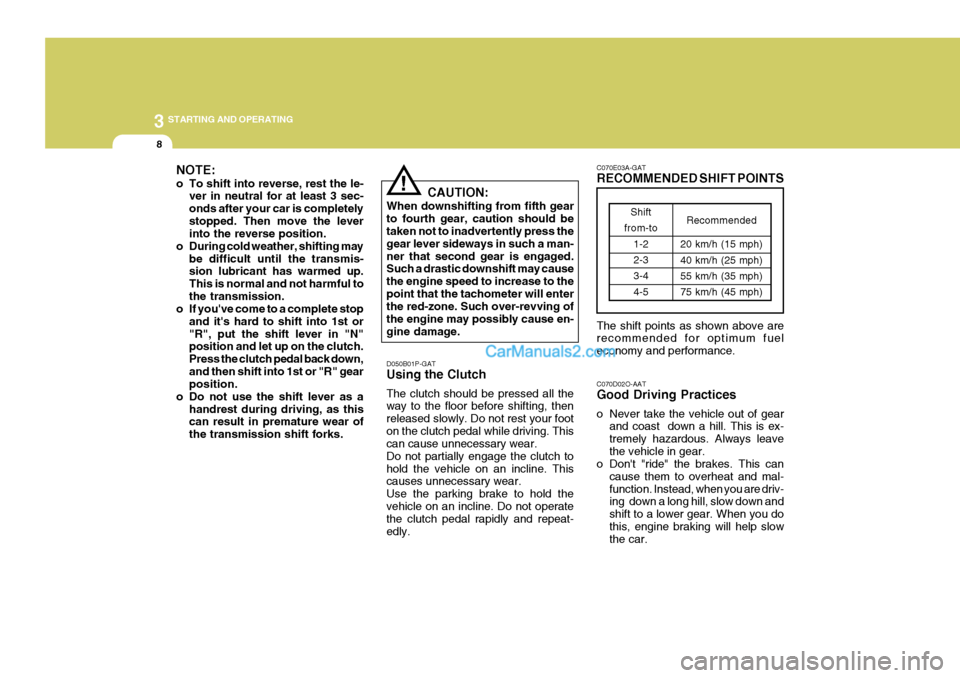
3 STARTING AND OPERATING
8
C070E03A-GAT RECOMMENDED SHIFT POINTS The shift points as shown above are recommended for optimum fuel economy and performance.
Shift
from-to 1-2 2-3 3-44-5 Recommended
20 km/h (15 mph)40 km/h (25 mph) 55 km/h (35 mph) 75 km/h (45 mph)
NOTE:
o To shift into reverse, rest the le- ver in neutral for at least 3 sec- onds after your car is completelystopped. Then move the lever into the reverse position.
o During cold weather, shifting may be difficult until the transmis-sion lubricant has warmed up. This is normal and not harmful tothe transmission.
o If you've come to a complete stop
and it's hard to shift into 1st or"R", put the shift lever in "N" position and let up on the clutch. Press the clutch pedal back down,and then shift into 1st or "R" gear position.
o Do not use the shift lever as a handrest during driving, as thiscan result in premature wear of the transmission shift forks. CAUTION:
When downshifting from fifth gearto fourth gear, caution should be taken not to inadvertently press the gear lever sideways in such a man-ner that second gear is engaged. Such a drastic downshift may cause the engine speed to increase to thepoint that the tachometer will enter the red-zone. Such over-revving of the engine may possibly cause en-gine damage.
!
D050B01P-GAT Using the Clutch The clutch should be pressed all the way to the floor before shifting, then released slowly. Do not rest your footon the clutch pedal while driving. This can cause unnecessary wear. Do not partially engage the clutch tohold the vehicle on an incline. This causes unnecessary wear. Use the parking brake to hold thevehicle on an incline. Do not operate the clutch pedal rapidly and repeat- edly. C070D02O-AAT Good Driving Practices
o Never take the vehicle out of gear
and coast down a hill. This is ex- tremely hazardous. Always leavethe vehicle in gear.
o Don't "ride" the brakes. This can
cause them to overheat and mal-function. Instead, when you are driv- ing down a long hill, slow down and shift to a lower gear. When you dothis, engine braking will help slow the car.
Page 77 of 205
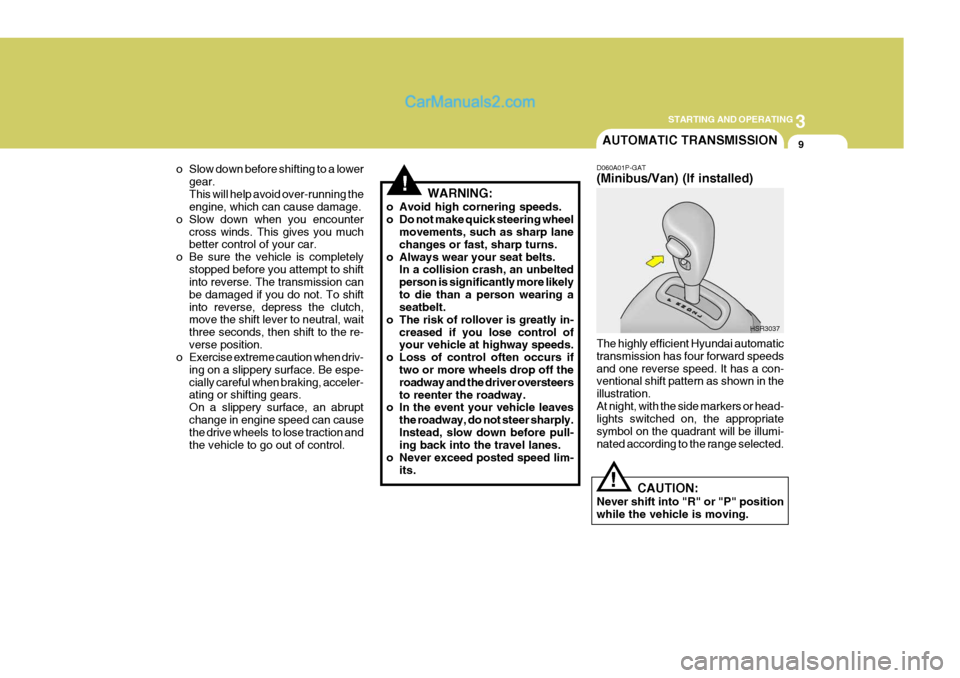
3
STARTING AND OPERATING
9
!
o Slow down before shifting to a lower
gear. This will help avoid over-running the engine, which can cause damage.
o Slow down when you encounter
cross winds. This gives you muchbetter control of your car.
o Be sure the vehicle is completely stopped before you attempt to shiftinto reverse. The transmission can be damaged if you do not. To shiftinto reverse, depress the clutch, move the shift lever to neutral, wait three seconds, then shift to the re-verse position.
o Exercise extreme caution when driv-
ing on a slippery surface. Be espe-cially careful when braking, acceler- ating or shifting gears. On a slippery surface, an abruptchange in engine speed can cause the drive wheels to lose traction and the vehicle to go out of control. WARNING:
o Avoid high cornering speeds.
o Do not make quick steering wheel movements, such as sharp lanechanges or fast, sharp turns.
o Always wear your seat belts. In a collision crash, an unbeltedperson is significantly more likelyto die than a person wearing a seatbelt.
o The risk of rollover is greatly in-
creased if you lose control ofyour vehicle at highway speeds.
o Loss of control often occurs if two or more wheels drop off the roadway and the driver oversteersto reenter the roadway.
o In the event your vehicle leaves
the roadway, do not steer sharply.Instead, slow down before pull- ing back into the travel lanes.
o Never exceed posted speed lim- its.
AUTOMATIC TRANSMISSION
D060A01P-GAT (Minibus/Van) (If installed) The highly efficient Hyundai automatic transmission has four forward speedsand one reverse speed. It has a con- ventional shift pattern as shown in the illustration.At night, with the side markers or head- lights switched on, the appropriate symbol on the quadrant will be illumi-nated according to the range selected. HSR3037
CAUTION:
Never shift into "R" or "P" positionwhile the vehicle is moving.
!